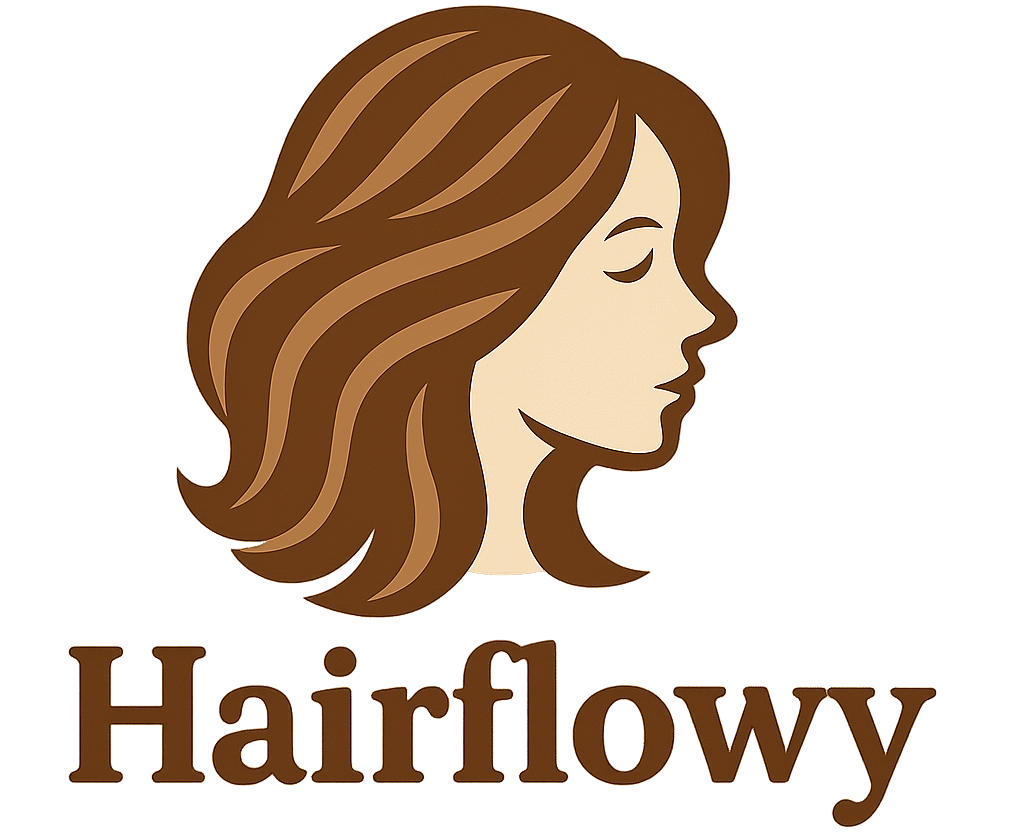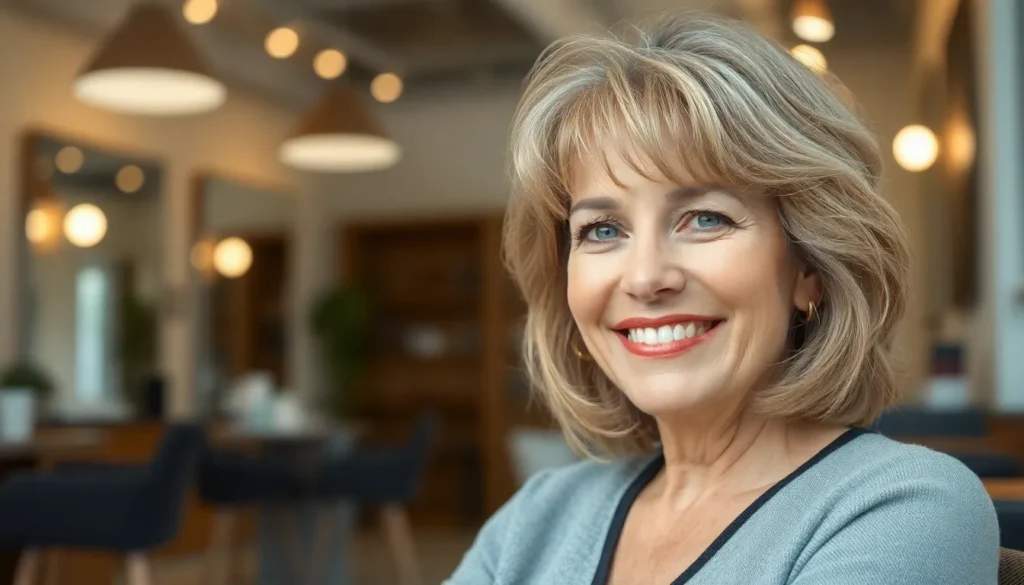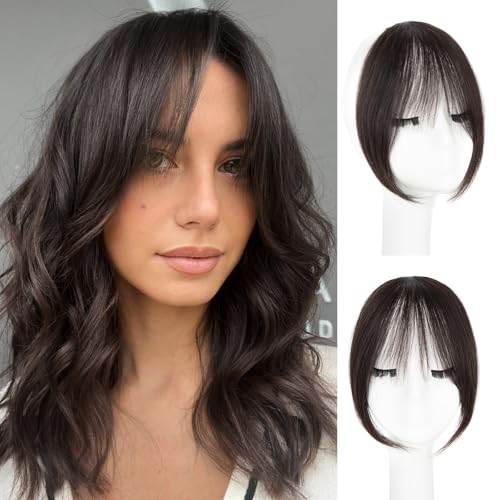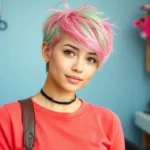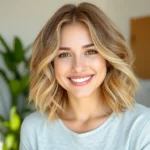Age-defying beauty doesn’t stop at 60 – it evolves into something even more sophisticated and confident. We’ve discovered that bangs can be the ultimate game-changer for women embracing their sixties and beyond, offering an instant refresh that takes years off your appearance while highlighting your best features.
Many women worry that bangs aren’t age-appropriate, but we’re here to debunk that myth completely. The right fringe style can soften fine lines, frame your face beautifully, and give you that youthful spark you’ve been searching for. From wispy curtain bangs to bold blunt cuts, there’s a perfect bang style waiting to transform your look.
We’ll guide you through the most flattering bang options specifically designed for mature women, helping you choose styles that complement your face shape, hair texture, and lifestyle. It’s time to embrace the groundbreaking power of bangs and discover how this simple change can revolutionize your entire appearance.
Why Bangs Are the Perfect Hair Solution for Women Over 60
Strategic face framing transforms how we approach mature beauty by creating natural focal points that draw attention upward. Bangs provide instant structure to thinning hair while camouflaging common aging concerns like forehead lines and crow’s feet. We’ve observed that women who embrace fringe styles often report feeling years younger without requiring expensive treatments or procedures.
Coverage benefits extend far beyond simple concealment as bangs strategically mask age spots, sun damage, and deepening forehead creases. Fine lines become less noticeable when soft fringe creates a gentle shadow effect across the upper face. We recommend consulting with stylists who understand how different bang lengths interact with mature skin texture and tone.
Volume enhancement becomes effortless when bangs add density to areas where hair naturally thins with age. Side-swept styles create the illusion of fuller hair while blunt cuts provide structure to wispy textures. We’ve found that layered bangs work particularly well for women experiencing crown thinning or receding hairlines.
Low maintenance styling appeals to busy women who want polished looks without extensive daily routines. Modern bang techniques require minimal styling products and simple blow-drying methods that most women can master at home. We suggest discussing maintenance schedules with stylists to ensure your chosen fringe style fits your lifestyle and grooming preferences.
Confidence boosting effects occur immediately after the right bang style is implemented, creating dramatic improvements in overall appearance. Properly cut fringe draws attention to eyes and cheekbones while minimizing less flattering features. We’ve witnessed countless transformations where women rediscover their youthful spark through strategic bang placement and professional cutting techniques.
Face-Framing Wispy Bangs for a Soft, Youthful Look

Wispy bangs offer the perfect blend of sophistication and softness that complements mature beauty effortlessly. These delicate, feathered layers create an elegant frame around your face while maintaining the airy, lightweight feel that prevents overwhelming your features.
How to Style Wispy Bangs for Different Face Shapes
Round faces benefit tremendously from side swept wispy bangs that create visual length and draw the eye upward. Position your bangs to start from a deep side part, allowing them to graze across your forehead at an angle rather than straight across.
Oval faces provide the most versatility for wispy bang placement, with eyebrow grazing lengths that accentuate your eyes and cheekbones beautifully. Center your wispy fringe or sweep it gently to either side based on your natural hair growth pattern.
Square faces require soft, textured wispy bangs that counteract angular jawlines and create feminine curves. Feather your bangs in varying lengths to avoid harsh, blunt lines that might emphasize the width of your face.
Heart shaped faces look stunning with curtain style wispy bangs that balance a wider forehead with a narrower chin. Part your bangs in the center and let them frame both sides of your face in gentle, wispy layers.
Maintenance Tips for Keeping Wispy Bangs Fresh
Regular trimming every 4 to 6 weeks maintains the precise length and delicate texture that makes wispy bangs so flattering for mature women. Schedule these appointments with your stylist to prevent overgrown bangs from losing their youthful appeal.
Light styling products work best for wispy bangs, with texturizing sprays and lightweight mousses adding volume without weighing down the delicate strands. Apply these products sparingly to maintain the airy, natural movement that defines this style.
Daily grooming keeps your wispy bangs looking polished and prevents them from appearing flat or greasy throughout the day. Use a small round brush to lift and separate the layers while blow drying on low heat.
Strategic hair coloring can enhance wispy bangs by adding subtle highlights or lowlights that create depth and dimension. Consider lightening the bang area slightly to brighten your complexion and add vibrancy to your overall look.
Side-Swept Bangs That Add Movement and Volume
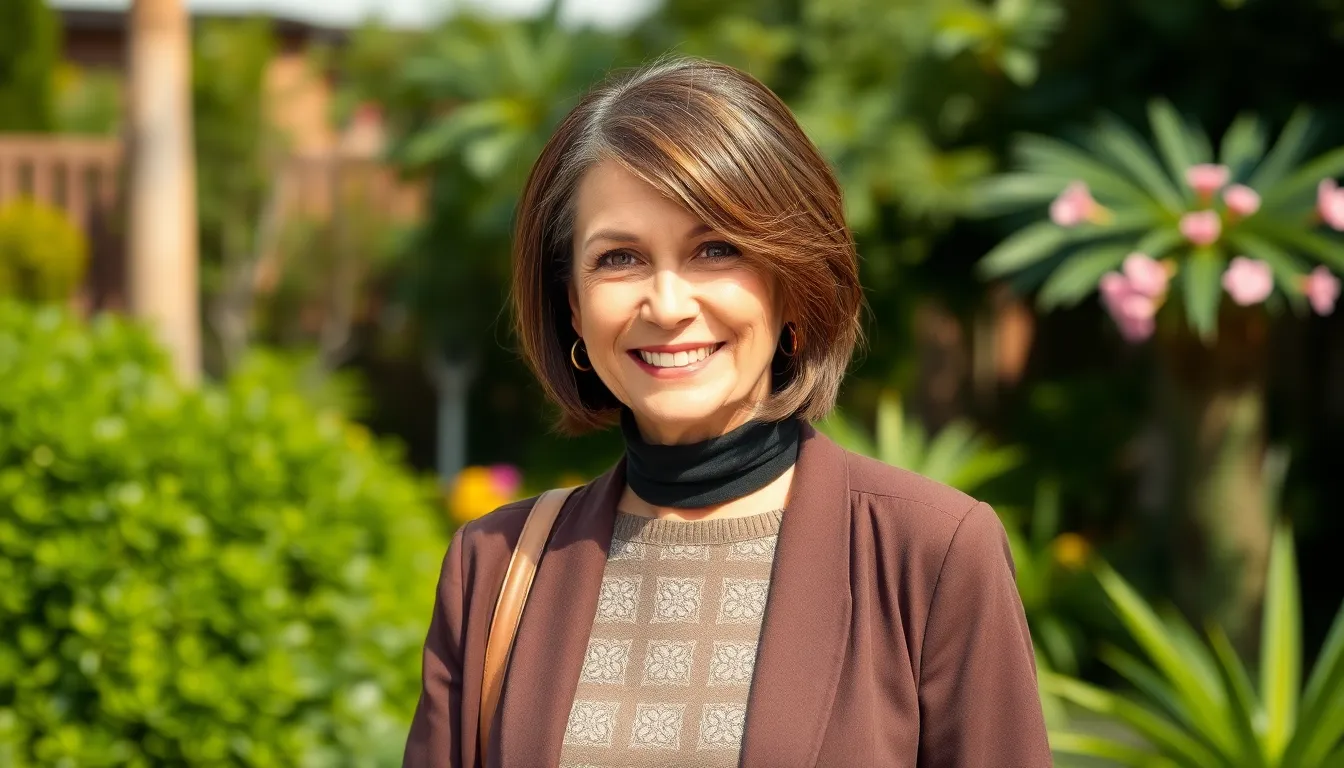
Side-swept bangs create a diagonal line across your face that naturally minimizes fine lines while adding mystery to your overall look. These versatile bangs pair beautifully with short hairstyles and work especially well for women with high foreheads or angular features.
Creating the Perfect Side-Swept Bang Shape
Achieving the ideal side-swept bang requires attention to three key elements that work together to create flattering results.
Length becomes your foundation when we aim for bangs that reach your eyebrows or fall slightly below, providing enough hair to sweep gracefully to one side. This measurement ensures you’ll have sufficient coverage while maintaining the freedom to style your bangs in different directions.
Layering adds dimension to your bangs, particularly beneficial if you’re working with fine hair that needs extra volume and texture. Strategic layers create movement that prevents your bangs from lying flat against your forehead, giving them the bounce and body that enhances your overall hairstyle.
Maintenance keeps your shape intact through regular trims that prevent uneven growth patterns from disrupting the sweep. We recommend scheduling touch-ups every 4-6 weeks to maintain the precise angle and length that makes side-swept bangs so flattering.
Styling Products That Enhance Side-Swept Bangs
The right products transform ordinary side-swept bangs into polished, professional-looking styles that last throughout the day.
Anti-frizz balm smooths flyaways and creates the sleek finish that makes your bangs look intentionally styled rather than windblown. Apply a small amount to damp bangs before styling to control texture and add shine.
Hair dryer and round brush combination gives you control over the direction and volume of your sweep. Use the brush to lift your bangs at the root while directing the airflow in your desired sweeping direction.
Flat iron provides precision when you want to create perfectly straight bangs or add a subtle curve to enhance the sweep. Run the iron lightly through your bangs after they’re dry to smooth any remaining bumps or kinks.
Highlights and root shadowing techniques add visual interest to your fringe area, creating depth that makes thin bangs appear fuller. These color techniques can make your side-swept bangs look more textured and voluminous without adding actual bulk.
Curtain Bangs for a Modern, Effortless Appearance

Curtain bangs create a versatile, face-framing style that parts in the middle and sweeps gracefully to both sides. This elegant fringe style offers women over 60 a contemporary look that enhances natural beauty while remaining surprisingly low-maintenance.
Adapting Curtain Bangs for Mature Features
Curtain bangs deliver exceptional benefits for mature women by working specifically with age-related changes. We’ve found they create a natural face-lift effect that softly frames facial features and reduces the appearance of fine lines and crow’s feet.
Volume becomes more achievable with curtain bangs since they add movement and create the illusion of thicker hair for those experiencing thinning. The sweeping style effectively camouflages forehead lines while drawing attention to your best features like cheekbones and eyes.
Versatility makes curtain bangs perfect for both casual coffee dates and formal dinner events. They grow out beautifully without creating awkward in-between stages, making them ideal for women who prefer less frequent salon visits.
Daily Styling Routine for Curtain Bangs
Styling curtain bangs requires minimal effort and products to maintain their effortless appearance. We recommend starting with a lightweight styling cream or serum applied to damp bangs to provide hold without weighing them down.
Finger styling works better than brushes for achieving that natural, lived-in look curtain bangs are known for. Gently sweep the bangs to create the center part, then use your fingertips to separate and position each side.
Heat styling tools should be used sparingly to preserve the natural texture and movement of curtain bangs. When you do use a blow dryer, direct the airflow downward while gently lifting the roots with your fingers to add subtle volume at the base.
Blunt Bangs That Make a Bold Fashion Statement

Blunt bangs offer the most dramatic transformation for women over 60, creating an instantly youthful and confident appearance. This striking style cuts straight across the forehead with precision, delivering a clean and bold look that softens facial features while drawing attention directly to your eyes.
Choosing the Right Length for Blunt Bangs
Finding the perfect length for your blunt bangs starts with positioning them right above your eyebrows for optimal face framing. We recommend this classic placement because it creates an ideal balance without overwhelming your facial features or appearing too heavy for mature skin.
Starting with a slightly longer length gives you flexibility to make adjustments as you become comfortable with your new look. Your stylist can always trim them shorter during your next visit, but adding length back requires patience and growth time.
Consider these length guidelines for different preferences:
| Length Option | Placement | Best For |
|---|---|---|
| Classic | Just above eyebrows | First-time bang wearers |
| Bold | At eyebrow line | Confident style statements |
| Dramatic | Mid-forehead | Maximum impact looks |
Professional consultation ensures your bang length complements your bone structure and lifestyle needs. We suggest discussing maintenance requirements with your stylist since blunt bangs typically need trimming every 4-6 weeks to maintain their sharp, clean appearance.
Face Shapes That Work Best with Blunt Styles
Round faces benefit most from blunt bangs because the straight horizontal line helps elongate and balance facial proportions. We’ve found that this style creates the illusion of length while drawing focus to your eyes and cheekbones rather than the width of your face.
Oval faces can confidently wear blunt bangs since this versatile face shape accommodates most bang styles beautifully. The key lies in choosing the right length and ensuring the cut complements your natural facial harmony without disrupting your balanced proportions.
Square faces gain softness from blunt bangs when paired with subtle layering or texturing techniques. We recommend asking your stylist to add gentle movement to prevent the bangs from appearing too severe against angular jawlines and cheekbones.
Heart shaped faces should consider combining blunt bangs with layered side sections to create better balance between a wider forehead and narrower chin. This approach prevents the bangs from emphasizing the top heaviness that can occur with this face shape.
Face shape compatibility for blunt bangs:
- Round faces: Create length and vertical lines
- Oval faces: Enhance natural balance and symmetry
- Square faces: Soften angular features with texture
- Heart shaped faces: Balance proportions with layered elements
Long faces might find blunt bangs too overwhelming since they can make the face appear shorter and wider than desired. We typically recommend side swept or curtain styles for this face shape to maintain natural proportions while still enjoying the benefits of bangs.
Feathered Bangs for Added Texture and Dimension
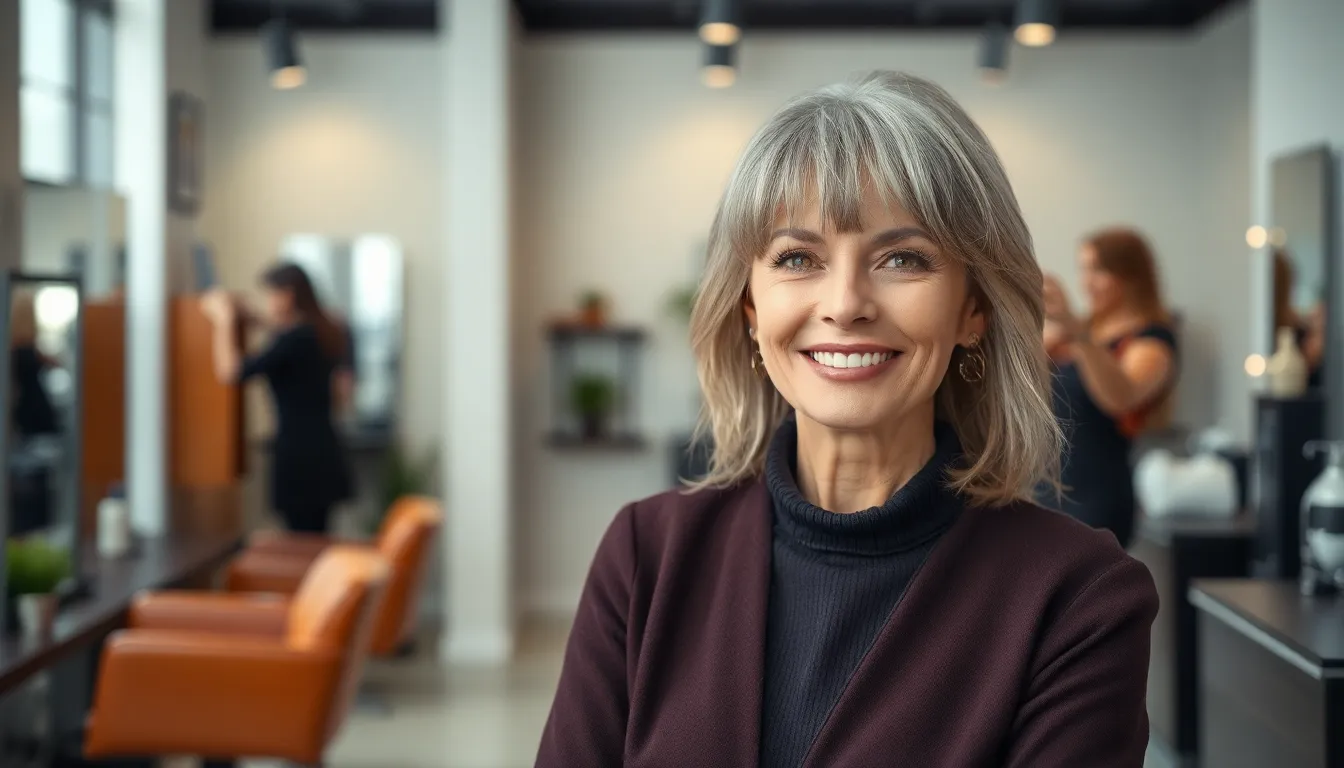
Feathered bangs create soft, layered edges that naturally blend with your hair while adding movement and reducing harsh lines that can emphasize aging. We’ve found these versatile bangs work beautifully for women over 60 seeking a modern, low-maintenance style that enhances facial structure.
Layering Techniques for Feathered Bang Styles
Point cutting creates the signature feathered texture that makes these bangs so flattering for mature women. Professional stylists use texturizing shears to thin and shape the hair, ensuring natural flow that seamlessly blends with other layers throughout your hairstyle.
Cutting bangs at strategic angles allows them to fall softly across your forehead while tapering naturally at the edges into your hairline. This angled approach prevents the blunt, harsh appearance that can make facial features appear more pronounced.
Adding layers helps boost volume and body, particularly beneficial for women experiencing fine or thinning hair concerns. We recommend discussing these layering techniques with your stylist to customize the depth and placement based on your hair density and face shape.
Feathered bangs adapt beautifully to various lengths including pixie cuts, bobs, and shoulder length styles, making them an ideal choice for women seeking versatile, age appropriate options.
Color Highlights That Complement Feathered Bangs
Subtle balayage techniques enhance the natural texture and dimension of feathered bangs while creating depth that frames your face beautifully. These hand painted highlights add movement without overwhelming your overall look.
Soft babylights brighten your complexion and minimize the appearance of fine lines around your eyes and forehead. We suggest choosing highlights that complement your skin tone for the most flattering results.
Natural gray blending works exceptionally well with feathered bangs, creating a sophisticated look that celebrates your natural color journey. This technique adds richness and depth while maintaining an elegant, refined appearance.
Strategic highlight placement should focus on the areas where your bangs naturally catch light, typically the outer edges and tips. Color specialists recommend keeping highlights within two shades of your base color for the most natural, youthful effect.
Long Bangs That Blend Seamlessly with Layered Hair
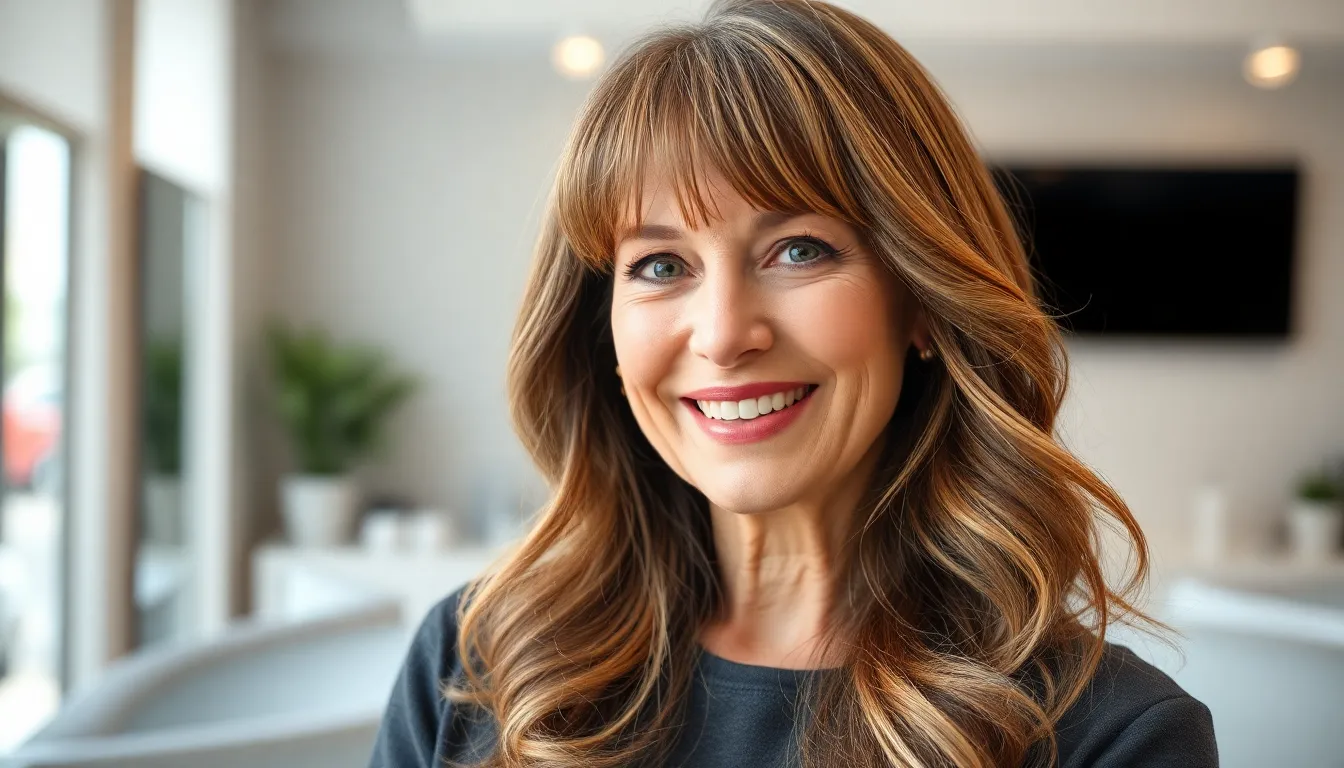
Long bangs offer an effortlessly elegant solution that creates natural movement while integrating beautifully with layered hairstyles. This versatile approach allows the fringe to flow naturally into your existing hair structure, creating a cohesive and sophisticated look.
Transitioning from Short to Long Bang Styles
Growing out shorter bangs requires patience and strategic styling techniques to maintain a polished appearance throughout the process. Regular trims every 4-6 weeks prevent split ends while allowing your bangs to gradually lengthen into your desired style.
Styling tools become essential during this transition period, with a quality hair dryer and round brush helping shape and direct your growing fringe. Anti-frizz balms work particularly well for managing flyaway hairs that often appear during the awkward growth phases.
Flat irons provide additional control when your bangs reach that challenging in-between length, allowing you to smooth and straighten stubborn sections. Professional stylists recommend using heat protectant products before applying any hot tools to prevent damage during this delicate growing phase.
Strategic trimming techniques help maintain shape while encouraging healthy growth, ensuring your bangs remain flattering rather than messy during the transition. We suggest booking regular appointments with your stylist to monitor progress and make minor adjustments as needed.
Professional Cutting Techniques for Long Bangs
Professional stylists use specialized cutting techniques that create long bangs specifically designed to frame mature facial features. Cutting bangs on a slant follows your natural face shape and creates flattering angles that enhance your eyes while softening angular features.
Point cutting techniques add texture and movement to long bangs, preventing them from appearing too heavy or blunt against mature skin. This method creates softer edges that blend naturally with layered hairstyles, particularly effective for women with fine or thinning hair.
Face-framing angles become crucial when cutting long bangs, with stylists carefully measuring proportions to ensure the fringe complements your bone structure. Quality hair cutting shears make precise cuts that prevent fraying and ensure clean lines that grow out gracefully.
Layered integration techniques allow long bangs to seamlessly connect with your existing haircut, creating a unified style rather than an obvious add-on element. Regular maintenance appointments every 6-8 weeks keep long bangs looking fresh and prevent overgrowth that can overwhelm facial features.
Stylists often recommend combining long side-swept bangs with medium or long layered hairstyles, creating a seductive and playful look that’s particularly flattering for women over 60.
Choppy Bangs for an Edgy, Contemporary Vibe
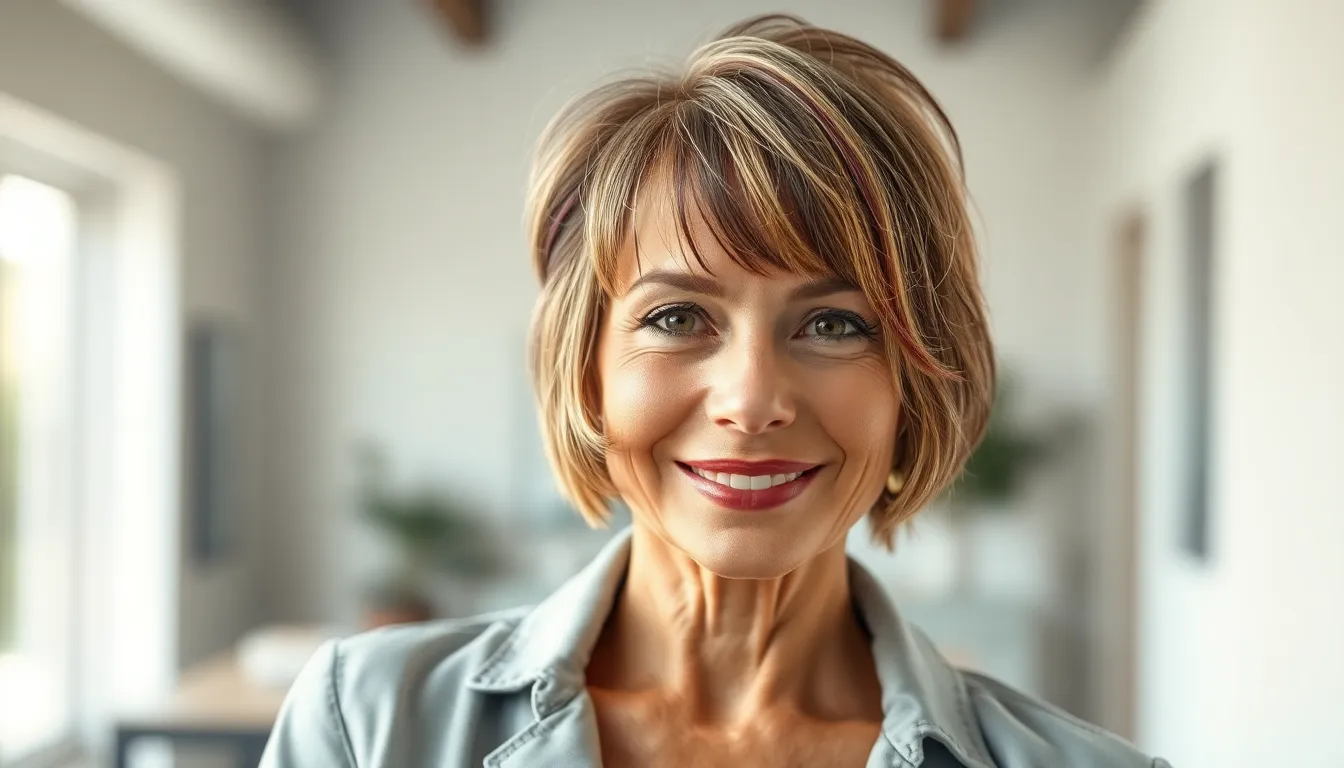
Choppy bangs bring textured, uneven layers that deliver a modern and youthful edge for women over 60. These edgy styles create movement and volume while effectively distracting from forehead lines and receding hairlines.
Personalizing Choppy Bangs for Your Lifestyle
Busy Schedule Answers: Women with demanding routines benefit from low-maintenance choppy bangs that blend seamlessly with layered, wash-and-wear hairstyles. These practical styles require minimal daily styling while maintaining their contemporary appeal.
Fashion-Forward Enhancement: Strategic highlights in bold colors like red or purple can amplify choppy bangs’ texture and modern flair. Color placement becomes crucial for creating depth and dimension that complements your personal style preferences.
Face Shape Considerations:
- Side-swept choppy bangs soften facial features for gentler looks
- Curtain-style choppy bangs create natural movement across the forehead
- Blunt choppy bangs deliver bold statement looks for confident wearers
Hair Texture Answers: Fine or thinning hair gains the illusion of fuller volume through layered choppy cuts. Lighter-toned highlights strategically placed within choppy layers create additional texture and density appearance.
Versatile Pairing Options: Choppy bangs complement various haircuts including textured pixies, tousled bobs, and layered shags. Both straight and wavy hair textures work beautifully with this contemporary fringe style.
Maintenance Schedule for Choppy Bang Styles
Regular Trimming Timeline: Schedule professional trims every 3 to 4 weeks to maintain the sharp, textured effect of choppy bangs. Consistent maintenance prevents split ends and preserves the edgy appearance that defines this style.
Daily Styling Routine: Apply lightweight volumizing products or texturizing sprays to enhance the choppy effect and improve manageability. Gentle brushing techniques help maintain the desired texture without flattening the layered structure.
Weekly Care Regimen:
- Wash hair 2-3 times weekly with gentle shampoo
- Apply conditioning treatments to maintain hair health
- Use anti-frizz serums for wavy or curly hair textures
Heat Styling Guidelines: Minimize heat tool usage to prevent damage to the delicate choppy layers. When heat styling is necessary, use protective products and lower temperature settings to preserve hair integrity.
Product Application Tips: Focus texturizing products on the bang area rather than the entire head for targeted enhancement. Light application prevents weighing down the choppy texture while maximizing movement and definition.
Styling Tips and Tools for Managing Bangs Over 60

Successfully maintaining beautiful bangs requires the right products and techniques that work specifically for mature hair. We’ve compiled essential tips to help you achieve salon-quality results at home while keeping your bangs healthy and stylish.
Essential Products for Bang Maintenance
Anti-frizz balm controls flyaways and keeps bangs smooth throughout the day, especially in humid conditions that can make hair unruly. Applying this product before styling creates a protective barrier that maintains your look longer.
Shine spray or serum adds glossy finish while minimizing the appearance of fine or thinning hair that’s common after 60. These products reflect light beautifully and give bangs a healthy, youthful appearance without weighing them down.
Lightweight hairspray sets your style without creating stiffness or making bangs look artificial. Choose alcohol-free formulas that provide flexible hold while allowing natural movement and bounce.
Heat protectant prevents damage when using styling tools and should be applied before any heat styling session. This essential step maintains hair health and prevents the brittleness that can occur with frequent styling.
| Product Type | Primary Benefit | Application Frequency |
|---|---|---|
| Anti-frizz balm | Controls flyaways | Daily before styling |
| Shine spray | Adds gloss, minimizes thinning | 2-3 times per week |
| Lightweight hairspray | Sets style without stiffness | Daily after styling |
| Heat protectant | Prevents styling damage | Before each heat styling |
Heat Styling Techniques for Different Bang Types
Smooth, straight bangs require a flat iron on low heat settings to prevent damage while achieving sleekness. Work from root to tip in small sections after applying heat protectant, moving the iron steadily to avoid creating dents or creases.
Wispy or feathered bangs benefit from a curling wand or round brush technique that adds soft movement and natural texture. Avoid heavy styling products that can weigh down these delicate styles and instead focus on creating gentle curves and flow.
Side-swept bangs need blow-drying with a paddle or round brush while directing hair to the desired side for that flirty, playful look. Start at the roots and sweep the brush in the direction you want your bangs to fall, using medium heat to set the style.
Curly or layered bangs work best with a diffuser attachment on your blow dryer to enhance natural curl patterns without creating frizz. Apply curl cream for definition before diffusing on low heat, scrunching gently to encourage natural texture and movement.
Remember to trim your bangs every 3 to 4 weeks to maintain their shape and prevent them from overwhelming your features as they grow out.
Common Mistakes to Avoid When Choosing Bangs After 60
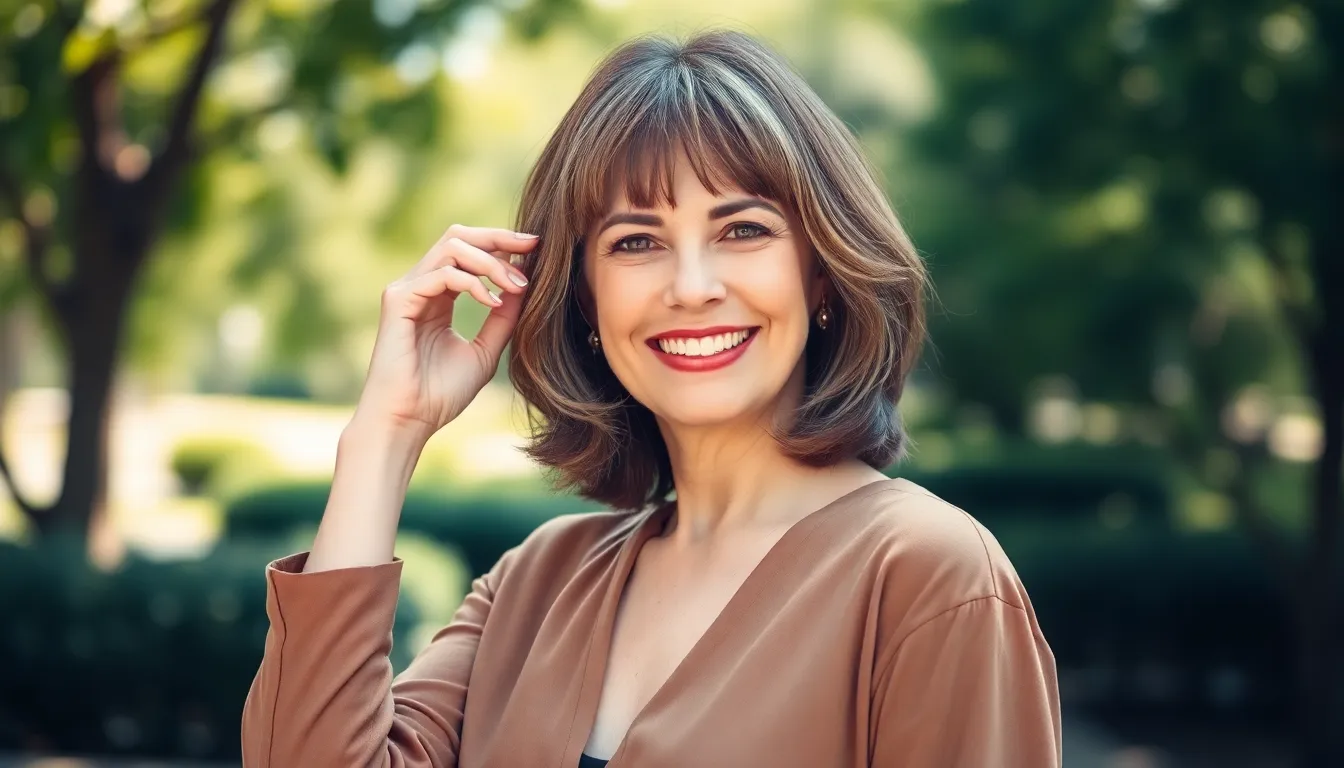
Selecting the wrong bang style can inadvertently emphasize aging features rather than enhance your natural beauty. We’ve identified key areas where mature women often make missteps when choosing their perfect fringe.
Working with Your Hair Texture and Density
Ignoring hair density leads to disappointing results. Thin hair requires wispy or piece-y bangs that create the illusion of thicker strands, while attempting heavy, blunt cuts on fine hair creates sparse, lifeless fringe. We recommend avoiding straight-across bangs on thinning hair since they’ll expose scalp visibility and lack the fullness needed for a polished appearance.
Thick hair presents different challenges that require careful consideration. Dense strands can support long, straight fringe or layered shag styles without appearing overwhelming. Choosing bangs that are too thin or wispy on thick hair creates an unbalanced look where the fringe gets lost against the fuller backdrop of your hairstyle.
Texture mismatches cause daily styling frustrations. Coarse hair needs softer, feathered edges rather than harsh lines that emphasize the rougher texture. Fine hair benefits from subtle layering techniques that add movement without creating gaps or uneven spacing between strands.
Natural cowlicks and growth patterns require professional assessment. We often see women attempt DIY bang cuts without considering how their hair naturally falls, resulting in sections that stick up awkwardly or refuse to lie flat against the forehead.
Considering Your Daily Hair Routine
Overestimating your styling commitment creates maintenance nightmares. High maintenance bang styles like short, textured fringe require daily styling with multiple products and heat tools. Busy lifestyles benefit more from curtain bangs or chic pixie cuts that maintain their shape with minimal intervention.
Underestimating the time investment leads to unkempt appearances. Even low maintenance bangs need regular trims every 3 to 4 weeks to prevent them from growing into your eyes or losing their intended shape. We suggest realistic scheduling before committing to any fringe style.
Product dependency becomes expensive and time consuming. Some bang styles require anti-frizz balm, volumizing mousse, shine spray, and heat protectant for daily maintenance. Consider whether you’re willing to invest in and apply these products consistently before choosing more demanding styles.
Lifestyle factors influence bang longevity throughout the day. Active women who exercise regularly or work in humid environments need styles that withstand sweat and moisture without becoming limp or frizzy. Side-swept or longer bangs typically hold up better than shorter, more structured options under these conditions.
Conclusion
We’ve explored how the right bangs can be a game-changer for women over 60 looking to refresh their style. From wispy and side-swept to choppy and curtain bangs each option offers unique benefits that enhance natural beauty while addressing common aging concerns.
The key lies in choosing a style that complements your face shape hair texture and lifestyle. With proper maintenance techniques and the right styling products you can achieve a polished look that boosts confidence and draws attention to your best features.
Remember that age should never limit your style choices. We encourage you to consult with a professional stylist who understands mature hair needs and can help you find the perfect fringe to complement your individual beauty. The right bangs can truly transform your entire look and help you feel fabulous at any age.
Frequently Asked Questions
Are bangs appropriate for women over 60?
Yes, bangs are absolutely appropriate and can be incredibly flattering for women over 60. The right fringe style can soften fine lines, frame the face beautifully, and create a youthful focal point. Modern bang styles are specifically designed to enhance mature features while addressing common aging concerns like forehead lines and thinning hair.
What are the best bang styles for mature women?
The most flattering bang styles for women over 60 include wispy face-framing bangs, side-swept bangs, curtain bangs, feathered bangs, and choppy textured bangs. These styles work well because they soften harsh lines, add volume to thinning hair, and can be customized to complement different face shapes and hair textures.
How do bangs help hide signs of aging?
Bangs effectively camouflage forehead lines, crow’s feet, age spots, and sun damage by creating a natural curtain over these areas. They draw attention upward to the eyes and cheekbones while providing structure to thinning hair. The right bang style creates a youthful focal point that minimizes less flattering features.
Are bangs high-maintenance for busy women over 60?
Many bang styles are surprisingly low-maintenance, especially choppy, wispy, and side-swept varieties. These styles require minimal daily styling with basic products like volumizing mousse and light hairspray. However, regular trims every 3-4 weeks are essential to maintain their shape and appearance.
What face shapes work best with bangs after 60?
Bangs can be adapted for all face shapes. Side-swept bangs soften angular features, curtain bangs create natural movement for round faces, and wispy bangs work well for heart-shaped faces. The key is consulting with a stylist to determine the right length and style that complements your specific face shape and features.
What products are essential for styling bangs over 60?
Essential products include anti-frizz balm for smooth styling, lightweight volumizing mousse for body, shine spray for healthy-looking hair, and heat protectant when using styling tools. A light-hold hairspray helps maintain the style without weighing down fine or thinning hair.
How often should I trim my bangs?
Bangs should be trimmed every 3-4 weeks to maintain their shape and prevent them from becoming too long or uneven. Regular maintenance is crucial for keeping bangs looking fresh and properly framing your face, especially as hair texture changes with age.
What mistakes should I avoid when choosing bangs after 60?
Avoid blunt, heavy bangs if you have fine hair, as they can emphasize thinning. Don’t ignore your hair’s natural texture or choose styles that require more maintenance than you can realistically manage. Also, avoid bangs that are too short or harsh, which can emphasize aging features rather than softening them.
Can I style bangs at home or do I need professional help?
While professional consultation is recommended for the initial cut, you can maintain and style bangs at home with the right products and techniques. Use gentle heat styling, work with your hair’s natural texture, and invest in quality styling tools. Regular professional trims ensure the best results.
Do bangs work with thinning hair?
Yes, bangs can actually help disguise thinning hair by creating volume and coverage where it’s most needed. Wispy, textured, and choppy bang styles work particularly well for fine or thinning hair because they don’t require density to look full and can be layered to create the illusion of thickness.
